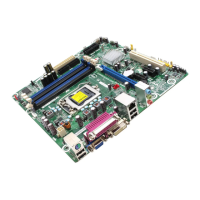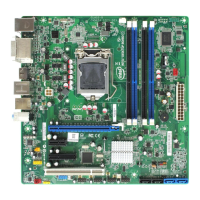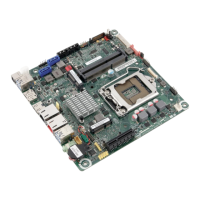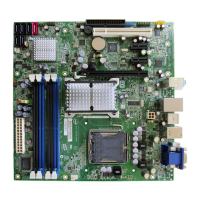Product Description
29
and graphics drivers allocate additional system memory to the graphics buffer as
needed for performing graphics functions.
NOTE
The use of DVMT requires operating system driver support.
1.7.1.3 Configuration Modes
A list of supported modes for the Intel GMA 3000 graphics controller is available as a
downloadable document.
For information about Refer to
Supported video modes for the board Section 1.2, page 17
1.7.1.4 Digital Video Interface (DVI)
The DVI port supports only DVI-D displays. If a DVI-I display is connected, only the
digital signal will be displayed. The maximum supported resolution is 1600 x 1200 at
60 Hz. The DVI port is compliant with the following specifications:
• DVI 1.0
• HDCP rev 1.1 down-stream compliant (when applicable)
Depending on the type of add-in card installed in the PCI Express x16 connector, the
DVI port will behave as described in
Table 6.
Table 6. DVI Port Status Conditions
PCI Express x16 connector status DVI port status
No add-in card installed Enabled
Non-video PCI Express x1 add-in card installed Enabled
PCI Express x4, x8, or 16 add-in card installed Disabled
ADD2 or MEC card installed Disabled
1.7.1.5 Advanced Digital Display (ADD2/MEC) Card Support
The GMCH routes two multiplexed SDVO ports that are each capable of driving up to a
200 MHz pixel clock to the PCI Express x16 connector. The SDVO ports can be paired
for a dual channel configuration to support up to a 400 MHz pixel clock. When an
ADD2/MEC card is detected, the Intel GMA 3000 graphics controller is enabled and the
PCI Express x16 connector is configured for SDVO mode. SDVO mode enables the
SDVO ports to be accessed by the ADD2/MEC card. An ADD2/MEC card can either be
configured to support simultaneous display with the primary VGA display or can be
configured to support dual independent display as an extended desktop configuration
with different color depths and resolutions. ADD2/MEC cards can be designed to
support the following configurations:
• TV-Out (composite video)
• Transition Minimized Differential Signaling (TMDS) for DVI 1.0
• Low Voltage Differential Signaling (LVDS)

